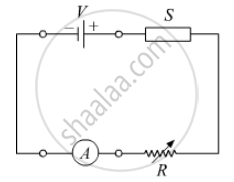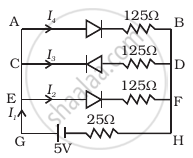Advertisements
Advertisements
Question
In the following diagram 'S' is a semiconductor. Would you increase or decrease the value of R to keep the reading of the ammeter A constant when S is heated? Give reason for your answer.

Solution
As the semiconductors at room temperature act as insulators so they offer very high resistance value. But with the increase in temperature, they start conducting by decreasing the energy-gap and hence they offer less resistivity. So, the resistivity of semiconductors decreases with the increase in temperature and as a result resistance also decreases.
So to maintain the constant reading on the ammeter, we should increase the value of variable resistance R to compensate with the decreased value of resistance for semiconductor.
APPEARS IN
RELATED QUESTIONS
What happens when a forward bias is applied to a p-n junction?
In the following diagram, is the junction diode forward biased or reverse biased ?
With reference to a semiconductor diode, what is meant by:
(i) Forward bias
(ii) Reverse bias
(iii) Depletion region
The drift current in a p-n junction is from the ______.
Depletion layer in p - n junction diode consists of
The expected energy of the electron at absolute zero is called:-
In the circuit shown in figure, if the diode forward voltage drop is 0.3 V, the voltage difference between A and B is ______.

If each diode in figure has a forward bias resistance of 25 Ω and infinite resistance in reverse bias, what will be the values of the current I1, I2, I3 and I4?

Draw the circuit arrangement for studying V-I characteristics of a p-n junction diode in (i) forward biasing and (ii) reverse biasing. Draw the typical V-I characteristics of a silicon diode.
An ideal PN junction diode offers ______.
